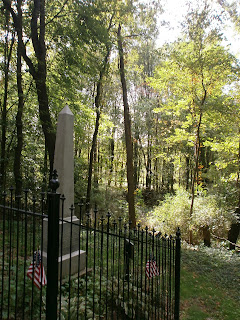It's time for an Ohio history lesson. Don't get too excited!
"James Copus
and three soldiers
George Shipley
John Tedrick
and Warnock (From what I've heard, the soldier who lost his life was named Robert Warnick?)
Killed by the Indians
Sept. 15 1812
So, I'm taking a leisurely drive today, and I drive past a well worn sign that is directing me to the Copus Massacre memorial. Needless to say, I was intrigued. I trucked down this little gravel road until I came upon this fenced in obelisk in the middle of the woods. It's a pretty uninspiring spot if you don't know the history behind the events. I'll post a link with the full story, but here's the short version:
James Copus and his family got along pretty well with their Native American neighbors. They all lived in relative peace around the area of present day Charles Mill Lake. However, soldiers popped up one day and wanted the Native Americans to move along and leave their land because the government was afraid they would turn violent. Mr. Copus tried to stick up for them, but to no avail. The only agreement he could come to with the military was for the Native Americans to temporarily move, on the condition that their homes would be left as they were. The Natives trusted Mr. Copus, so they went with the plan. This is the point where the soldiers ruined everything. As soon as the Natives were just a short distance away, the soldiers stole all the valuables the Natives had and set their village on fire. Mr. Copus was extremely upset because the trust that was between his friends and family and the Natives was shattered. In short, the Natives rebelled as a result of the destruction of their homes, and Mr. Copus and three soldiers were killed in the melee.
Although these violent deaths are bloody and terrible, I can fully understand the anger of the Natives. Americans have a long history of breaking promises and stealing land/resources from Native Americans. Mistreatment like this is bound to result in some sort of bloodshed. Maybe I'm callous, but I cannot consider these soldiers heroes because they committed such a dishonest, cowardly act, and reaped the consequences of their actions. The Copus family and their neighbors were caught in the middle, so I do feel very sorry for them because they tried to create a peaceful balance with the Native American neighbors. The abuse of Native Americans in our country is truly one of the most shameful acts we have committed as a nation (an act that we often times like to forget happened).
Full article on The Copus Massacre:
















